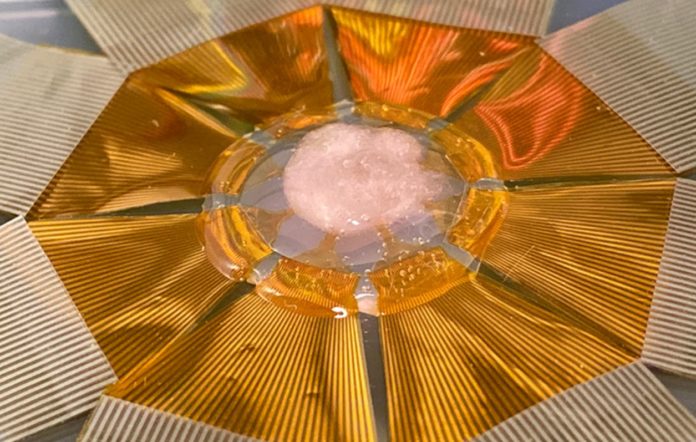Engineers from the University of California, San Diego, have invented a revolutionary new instrument that uses microscopic “pop-up” sensors to monitor the electrical activity inside heart cells without hurting them.
The device, which is the first of its kind, directly detects the movement and speed of electrical signals moving within a single heart cell as well as between several cardiac cells, marking a significant breakthrough. It’s also the first time these signals have been measured inside 3D tissue cells.
The invention, described in the journal Nature Nanotechnology, could help scientists learn more about heart abnormalities and diseases include arrhythmia (abnormal heart rhythm), heart attack, and cardiac fibrosis (stiffening or thickening of heart tissue).
“Studying how an electrical signal propagates between different cells is important to understand the mechanism of cell function and disease,” says Yue Gu, first author.
“Irregularities in this signal can be a sign of arrhythmia, for example. If the signal cannot propagate correctly from one part of the heart to another, then some part of the heart cannot receive the signal so it cannot contract.”
“With this device, we can zoom in to the cellular level and get a very high resolution picture of what’s going on in the heart; we can see which cells are malfunctioning, which parts are not synchronized with the others, and pinpoint where the signal is weak,” adds Sheng Xu, senior author.
“This information could be used to help inform clinicians and enable them to make better diagnoses.”
The gadget is made up of a 3D array of tiny field effect transistors (FETs) formed like sharp pointed ends. These small FETs can breach cell membranes without causing damage and are sensitive enough to detect electrical signals—even very weak ones—directly inside cells. The FETs are covered in a phospholipid bilayer to avoid being recognized as a foreign substance and to stay inside the cells for lengthy periods of time. The FETs may simultaneously detect signals from several cells. They can even keep track of signals from two distinct locations within the same cell.
“That’s what makes this device unique,” says Gu. “It can have two FET sensors penetrate inside one cell—with minimal invasiveness—and allow us to see which way a signal propagates and how fast it goes. This detailed information about signal transportation within a single cell has so far been unknown.”
The FETs were first produced as 2D shapes, and then selected spots of these shapes were glued to a pre-stretched elastomer sheet to create the device. The researchers next loosened the elastomer sheet, which buckled the device and caused the FETs to fold into a 3D shape, allowing them to penetrate into cells.
“It’s like a pop-up book,” adds Gu. “It starts out as a 2D structure, and with compressive force it pops up at some portions and becomes a 3D structure.”
The device was put through its paces on heart muscle cell cultures and lab-grown cardiac tissues. The experiments consisted of placing either cell culture or tissue on top of the device and then monitoring the electrical signals picked up by the FET sensors. The team was able to determine which sensors detected a signal first and then measure the time it took for other sensors to detect the signal by looking at which sensors detected the signal first and then analyzing the time it took for other sensors to detect the signal. For the first time, the researchers were able to achieve this for signals flowing between neighboring cells as well as signals traveling within a single heart muscle cell.
The fact that this is the first time scientists have been able to quantify intracellular signals in 3D tissue constructs adds to the excitement, according to Xu.
“So far, only extracellular signals, meaning signals that are outside of the cell membrane, have been measured in these types of tissues. Now, we can actually pick up signals inside the cells that are embedded in the 3D tissue or organoid,” he adds.
Signals inside individual heart cells travel nearly five times faster than signals between many heart cells, according to the team’s research. These kinds of information, according to Gu, could give insights about heart problems at the cellular level.
“Say you’re measuring the signal speed in one cell, and the signal speed between two cells. If there’s a very big difference between these two speeds—that is, if the intercellular speed is much, much smaller than the intracellular speed—then it’s likely that something is wrong at the junction between the cells, possibly due to fibrosis,” he says.
This device might also be used by biologists to analyze signal transmission between different organelles in a cell, according to Gu. This type of technology could also be used to test novel medications to evaluate how they affect heart cells and tissues.
The device could also be used to investigate the neuronal electrical activity. The team is interested in going in this path next. The researchers hope to utilize this technology in the future to monitor electrical activity in live biological tissue. Xu envisions a gadget that can be implanted on the surface of a beating heart or the cortex.
However, the device is still a long way from that point. To get there, the researchers must fine-tune the architecture of the FET sensors, optimize the size and materials of the FET array, and integrate AI-assisted signal processing algorithms into the system.
Source: 10.1038/ s41565-021-01040-w
Image Credit: Yue Gu
You were reading: Intuitive ‘pop-up’ sensors can detect even very weak hearts
